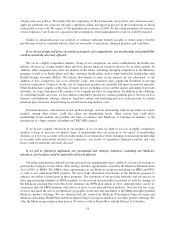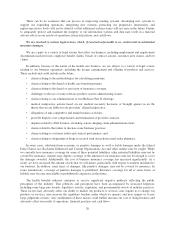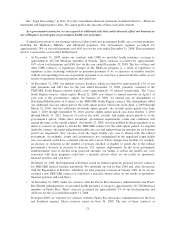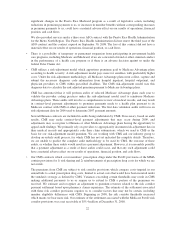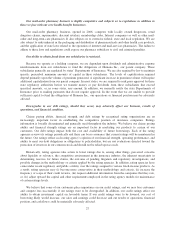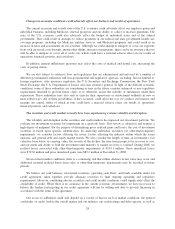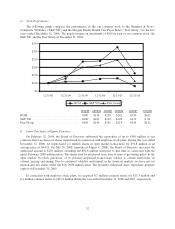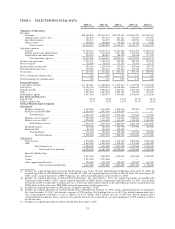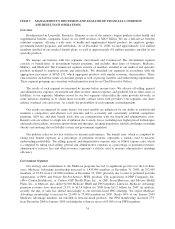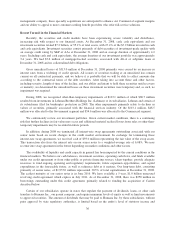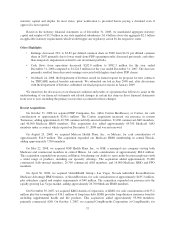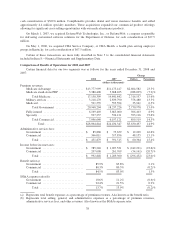Humana 2008 Annual Report Download - page 38
Download and view the complete annual report
Please find page 38 of the 2008 Humana annual report below. You can navigate through the pages in the report by either clicking on the pages listed below, or by using the keyword search tool below to find specific information within the annual report.Changes in economic conditions could adversely affect our business and results of operations.
The current recession and overall state of the U.S. economy could adversely affect our employer group and
individual business, including Medicare, renewal prospects and our ability to collect or increase premiums. The
state of the U.S. economy could also adversely affect the budget of individual states and of the federal
government. That could result in attempts to reduce payments in our federal and state government health care
coverage programs, including the Medicare, military services, and Medicaid programs, and could result in an
increase in taxes and assessments on our activities. Although we could attempt to mitigate or cover our exposure
from such increased costs through, among other things, increases in premiums, there can be no assurance that we
will be able to mitigate or cover all of such costs which could have a material adverse effect on our results of
operations, financial position, and cash flows.
In addition, general inflationary pressures may affect the costs of medical and dental care, increasing the
costs of paying claims.
We are also subject to extensive laws and regulations that are administered and enforced by a number of
different governmental authorities and non-governmental self-regulatory agencies, including, but not limited to,
foreign regulators, state insurance regulators, the U.S. Securities and Exchange Commission, the New York
Stock Exchange, the U.S. Department of Justice and state attorneys general. In light of the difficult economic
conditions, some of these authorities are considering or may in the future consider enhanced or new regulatory
requirements intended to prevent future crises or to otherwise assure the stability of institutions under their
supervision. These authorities may also seek to exercise their supervisory or enforcement authority in new or
more robust ways. All of these possibilities, if they occurred, could affect the way we conduct our business and
manage our capital, either of which in turn could have a material adverse effect our results of operations,
financial position, and cash flows.
The securities and credit markets recently have been experiencing extreme volatility and disruption.
The volatility and disruption in the securities and credit markets has impacted our investment portfolio. We
evaluate our investment securities for impairment on a quarterly basis. This review is subjective and requires a
high degree of judgment. For the purpose of determining gross realized gains and losses, the cost of investment
securities is based upon specific identification. In analyzing individual securities for other-than-temporary
impairments, we consider factors affecting the issuer, factors affecting the industry within which the issuer
operates, and general debt and equity market trends. We also consider the length of time an investment’s fair
value has been below its carrying value, the severity of the decline, the near-term prospects for recovery to cost,
and our intent and ability to hold the investment until maturity or market recovery is realized. During 2008, we
realized losses associated with other-than-temporary impairments of $103.1 million. Gross unrealized losses
were $313.0 million and gross unrealized gains were $83.2 million at December 31, 2008.
Given current market conditions, there is a continuing risk that further declines in fair value may occur and
additional material realized losses from sales or other-than-temporary impairments may be recorded in future
periods.
We believe our cash balances, investment securities, operating cash flows, and funds available under our
credit agreement, taken together, provide adequate resources to fund ongoing operating and regulatory
requirements. However, continuing adverse securities and credit market conditions could significantly affect the
availability of credit. While there is no assurance in the current economic environment, we have no reason to
believe the lenders participating in our credit agreement will not be willing and able to provide financing in
accordance with the terms of the agreement.
Our access to additional credit will depend on a variety of factors such as market conditions, the general
availability of credit, both to the overall market and our industry, our credit ratings and debt capacity, as well as
28


